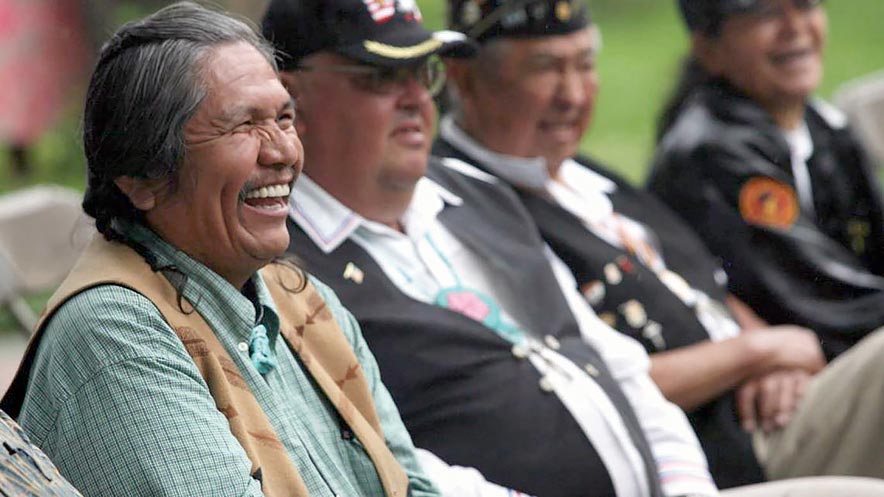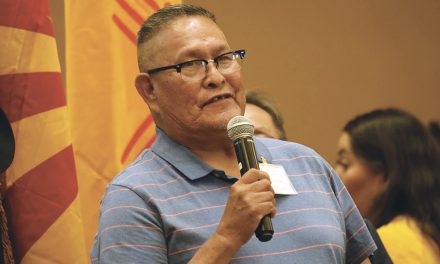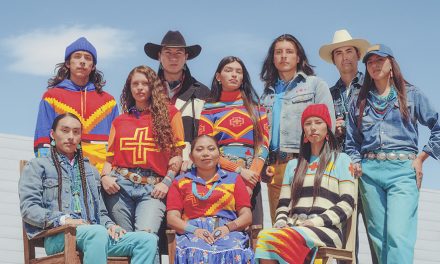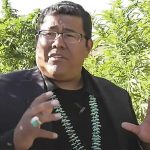
Native News | Longtime leader of Native American Wanapum band dead at 66

Tri-City Herald file | Paul T. Erickson Rex Buck Jr. laughs at a joke during the dedication ceremony for the Sacajawea State Park Interpretive Center in Pasco in 2007. Buck, the leader of the Wanapum Band, died Feb. 11.
KENNEWICK, Wash. (AP)
The longtime leader of the Wanapum band of Native Americans has died.
Rex Buck Jr., 66, died Feb. 11 at his ancestral village of P’na at Priest Rapids on the Columbia River in Grant County, Washington, according to an obituary distributed by the Grant County Public Utility District on Monday. No cause of death was listed.
The Tri-City Herald reported that the Wanapum band lived at the Hanford Nuclear Reservation site until the land was seized during World War II, and the Wanapum were forced to resettle at their winter campsite Priest Rapids.
“Rex was thoughtful and sincere, a leader who took his responsibility to the land seriously, consistently ensuring that the department understood the perspectives and priorities of the Wanapum people,” said Brian Vance, the U.S. Department of Energy’s Hanford manager.
According to the obituary, Buck was given the responsibility of leading the Wanapum people while still in his 20s. He was relentless in his support of Wanapum culture, the obituary said.
With his wife, Angela, he worked to build the Wanapum Heritage Center in 2015 on Highway 243. The museum tells the story of the Wanapum people. According to his obituary, it is also a place where the Wanapum can pass on their language and traditional lifestyle to new generations.
He also helped repatriate hundreds of ancestors and tens of thousands of objects for multiple Columbia River tribal nations as part of the Burke Museum’s commitments under the Native American Graves Protection and Repatriation Act.
Buck is survived by his wife, seven children, and grandchildren.
Tribe confronts crisis of missing, murdered women
YUROK RESERVATION, Calif. (AP) — The young mother had behaved erratically for months, hitchhiking, and wandering naked through two Native American reservations and a small town clustered along Northern California’s rugged Lost Coast.
But things escalated when Emmilee Risling was charged with arson for igniting a fire in a cemetery. Her family hoped the case would force her into mental health and addiction services. Instead, she was released over the pleas of loved ones and a tribal police chief.
The 33-year-old college graduate — an accomplished traditional dancer with ancestry from three area tribes — was last seen soon after walking across a bridge in a remote sliver of the Yurok Reservation.
Her October disappearance is one of five instances in the past 18 months where Indigenous women have gone missing or been killed in this isolated expanse of coastline between San Francisco and Oregon.
The crisis has prompted the Yurok Tribe to declare a state of emergency and increased urgency to efforts to build the first comprehensive database of such cases in California.
“Just in this last year, I knew three of the women who have gone missing or were murdered — and we shared so much in common,” said Blythe George, a Yurok citizen and assistant sociology professor helping document the problem. “You can’t help but see yourself in those people.”
The recent cases spotlight an epidemic that is difficult to quantify but has long disproportionately plagued Native Americans.
A 2021 report by a government watchdog group found the actual number of missing and murdered Indigenous women is unknown due to reporting problems, distrust of law enforcement, and jurisdictional conflicts.
But Native American women face murder rates almost three times those of white women overall — and up to 10 times the national average in specific locations, according to a 2021 summary of research by the National Congress of American Indians. More than 80% have experienced violence.
Emmilee is an enrolled Hoopa Valley tribal member who traces her ancestry to the Yurok and Karuk nations.
Many see in her story the ugly intersection of the trauma inflicted on Native Americans by their white colonizers and their marginalization in a justice system established by European conquerors.
Her case has shaken the community but gotten no outside attention.
Man who admitted killing bald eagle gets 30 days for feather
SHREVEPORT, La. (AP) — A 20-year-old Louisiana man has been sentenced to 30 days in prison, and a year on supervised release for possessing a bald eagle feather, federal prosecutors said Feb. 16.
Daniel Glenn Smith of Homer was sentenced the day before in Shreveport for violating a law that says only federally recognized Native American tribes may possess any part of a bald or golden eagle, U.S. Attorney Brandon B. Brown said in a news release.
This is the same law that former New York Gov. Andrew Cuomo unknowingly broke when he picked up an eagle feather from a lake and unwittingly confessed to when he told about the incident in 2018.
However, Smith did more. A statement signed when he pleaded guilty in October 2021 says he admitted killing an eagle, taking one feather from it, and keeping the feather in his car.
“The American bald eagle is a symbol of our American freedom. … This defendant did not take this symbol seriously, nor the laws that prohibit anyone from killing or possessing even a feather of a bald eagle,” Brown said.
According to the plea agreement, Magistrate Judge Mark Hornsby could have sentenced Smith to a year in prison and imposed a $5,000 fine. According to the U.S. Fish and Wildlife Service, the maximum fine for a first offense is $100,000.
Brown’s news release stated that the Louisiana Department of Wildlife and Fisheries began its investigation after learning that Smith had been photographed with a dead bald eagle. A search of Smith’s vehicle turned up the feather.
Smith had previously been placed on probation and ordered not to possess a firearm for one year due to hunting violations involving other wildlife, Brown said.
In 2017, the Bald and Golden Eagle Protection Act was among laws invoked when authorities broke up what a federal prosecutor in South Dakota called ?a chop shop for eagles.” That investigation brought 31 indictments; 17 people and two pawn shops were sentenced in 2018.
Pipestem inducted into OSU Hall of Fame
STILLWATER, Okla. – The Oklahoma State University Alumni Association inducted Otoe-Missouria tribal citizen Wilson K. Pipestem into the OSU Hall of Fame on Feb. 11.
Induction is the university’s highest honor for alumni or former students, recognizing their outstanding professional achievements and contributions to society.
Pipestem was previously honored as the university’s Distinguished American Indian Alumni in 2013.
Pipestem, who grew up in Norman, Oklahoma, is also of Osage and Potawatomi descent.
He served as president of the Native American Student Association as an undergraduate at OSU and was a scholarship athlete competing for the university’s track and cross-country teams.
Pipestem graduated with a bachelor’s degree in English in 1992 before earning his law degree from Stanford University in 1995.
Pipestem said, “While I’m humbled to represent the Otoe-Missouria Tribe, as well as the Osage and Potawatomi people in this hall of fame, I recall the remarkable Native leaders that attended Oklahoma State and led the way for me … our tribal communities remain underrepresented in these honors.
“I hope we are joined in this hall by even more of our well-deserving Native brothers and sisters very soon,” he said.
Pipestem is the founding partner of Pipestem & Nagle, PC, and founder of Ietan Consulting, LLC.
He has helped tribal nations get former tribal lands back into the tribal land base, reaffirming reservation boundaries in Oklahoma in post-McGirt v. Oklahoma litigation, and stopping attacks on tribal sovereignty.
He also served as lead counsel in Osage Nation v. United States, which was settled in favor of the Osage Nation after 11 years of litigation for a record $380 million.
Rob McInturf, president of the OSU Alumni Association, said, “He is an outstanding example of an Oklahoma State University graduate who is passionate, selfless and dedicated to improving the lives of others.”
Pipestem his wife, Brenda, Eastern Band of Cherokee Indians, reside in Skiatook, Oklahoma, and have four children. He is a lifetime member of the OSU Alumni Association.
Private grant funds SD AG’s missing Indigenous coordinator
PIERRE, S.D. (AP) — An office in the South Dakota attorney general’s office to coordinate investigations into the disappearance and murder of Indigenous people will be started through a private donation from an organization connected to St. Joseph’s Indian School.
Native American lawmakers who have been pushing for the funding in the state budget said on Feb. 16 they hoped the three-year grant of $85,000 a year from Native Hope would lead to Attorney General Jason Ravnsborg hiring someone soon.
The office, designed to coordinate law enforcement investigations across tribal, state, and federal agencies, was created last year but without funding to hire anyone.
“We want to impact this critical issue in our state,” said Jennifer Long, the director of Native Hope. “No more missing sisters; no more missing Indigenous people.”
The announcement comes after two women were found dead on the Pine Ridge Indian Reservation last week.
“In Pine Ridge, the Oglala Sioux Tribe public safety is underfunded,” said Democratic Rep. Peri Pourier. “This is an outstanding opportunity to bridge those gaps of all people coming together and saying what can we do?”
Gov. Kristi Noem is also pushing for ongoing funds for the position.








 Highway 264,
Highway 264, I-40, WB @ Winslow
I-40, WB @ Winslow